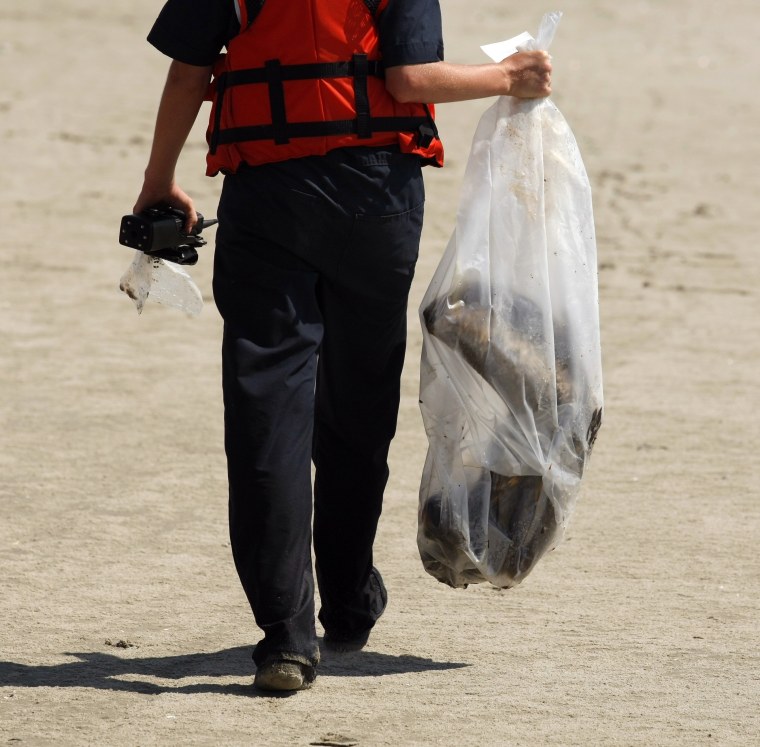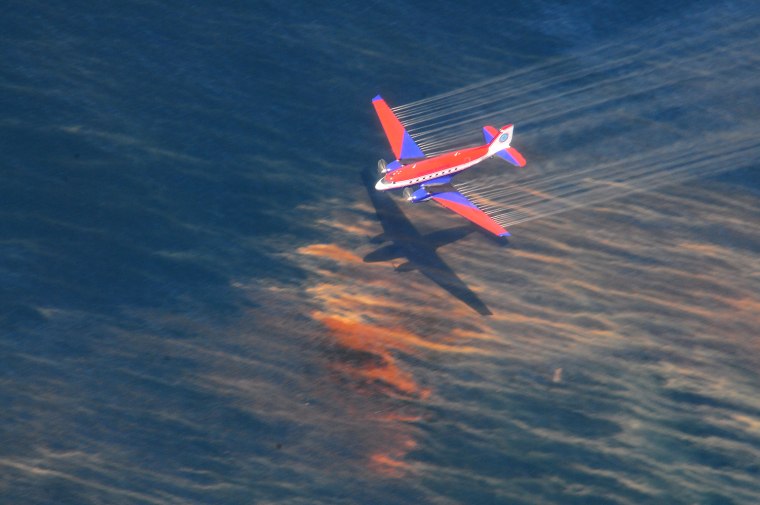That 5,000 barrels a day estimate for the BP spill? It went out the window on Thursday after both BP and the federal government came under fire for having stuck to it for nearly a month. BP also took some blows from the Obama administration, which demanded it put more data online and use less-toxic dispersants.
A task force of scientists is now reviewing video and reassessing the earlier 5,000 barrels per day estimate, Jane Lubchenco, head of the National Oceanic and Atmospheric Administration, told reporters.
Earlier Thursday, BP appeared to concede a higher number when it said that while its tube system was now bringing up 5,000 barrels a day of oil and natural gas from the larger of two leaks, that was not the entire flow still spewing out.
"We're not claiming that we stopped it — although that is our final objective," said BP spokesman Mark Proegler. "We're saying that this is what we're capturing now."
Proegler also said that "the oil plume escaping from the riser pipe has visibly declined today."
However, a live video feed of the leak provided by BP to lawmakers showed a black plume still billowing out into the deep waters.
"It's just not working," Sen. Barbara Boxer, D-Calif., told CNN as she watched the live video.
Boxer, chairwoman of the Senate Environment and Public Works Committee, cited estimates by scientists who believe the leak is much larger — 70,000 barrels per day or even more.
"The truth needs to be told ... At some point we need to stop all this cover-up," Boxer said.
Steve Wereley, associate mechanical engineering professor at Purdue University, said most independent estimates of the spill flow were "considerably higher than BP's."
"This is not rocket science," Wereley told a House committee hearing on Wednesday.
Lubchenco acknowledged that established techniques exist to estimate oil flow. But using them properly would have required better video and/or more robotic submarines around the blown-out well at a time when efforts have been on trying to stop the leaks, she said.
BP 'must' make more data public
BP also came under fire Thursday from the Obama administration.
In a letter, BP Chief Executive Tony Hayward was asked to create a website within 24 hours and post detailed environmental and analytical data within 48 hours.
"BP must update this data and information daily," Homeland Security Secretary Janet Napolitano and Environmental Protection Agency chief Lisa Jackson wrote.
"It is critical that all actions be conducted in a transparent manner, with all data and information related to the spill readily available to the United States Government and the American people," they added. "Those efforts, to date, have fallen short in both their scope and effectiveness."
BP was also instructed by the EPA to look for less-toxic chemicals to disperse oil from the spill.
BP Managing Director Bob Dudley told msnbc on Thursday that the company is testing four possible alternatives. BP hopes to go with one but constraints include getting enough quantity quickly, he said.
The EPA "is well aware of our operational constraints," Dudley said on "Andrea Mitchell Reports".
"If available and with their approval we'll make those modifications," he added.
If the EPA asks that BP stop using dispersants until it's happy with the mix, he said, "we will certainly do that."
The Washington Post earlier reported that the EPA informed BP late Wednesday that it has 24 hours to choose less toxic chemicals and must apply the new form of dispersants within 72 hours of submitting the list of alternatives.
BP has used two dispersants, Corexit 9500A and Corexit 9527A, so far applying 600,000 gallons on the surface and 55,000 gallons below the sea.
"While the dispersant BP has been using is on the Agency's approved list, BP is using this dispersant in unprecedented volumes and, last week, began using it underwater at the source of the leak — a procedure that has never been tried before," the EPA said in a statement Thursday. "Because of its use in unprecedented volumes and because much is unknown about the underwater use of dispersants, EPA wants to ensure BP is using the least toxic product authorized for use."
In a statement, BP noted that Corexit "is a bio-degradable surface-washing agent that has been approved by the US Environmental Protection Agency and the US Coast Guard."
"Corexit was readily available in the quantities required by the spill response plan which was pre-approved by the government for use in spill response," BP added. "It has been very effective in causing the oil to form into small, isolated droplets that remain suspended until they’re either eaten by naturally occurring microbes, evaporate, are picked up, or dissolve."
The confusion over the flow size and steps to clean up the mess fueled frustration.
Commercial fisherman Pete Gerica of New Orleans, a member of the Louisiana Seafood Promotion and Marketing Board, said the oil industry "needed to have a better tool box." As for the government, he said, "The watchdog people failed us miserably."
Larry Schweiger, president and CEO of the National Wildlife Federation, said the government — not BP — should be directing the response to the oil spill, including attempts to cap the gushing well.
"The Gulf of Mexico is a crime scene and BP cannot be left in charge of assessing the damage or controlling the data from their spill. The public deserves sound science, not sound bites from BP's CEO," Schweiger said.
Marshes hit
In Louisiana, heavy, sticky oil from the massive monthlong spill was starting to clog marshes as another edge of the partly submerged crude reached a powerful current that could take it to Florida and beyond.

A young brown pelican, one wing and its neck matted with oil, was found dead Thursday morning on a sand spit in the Breton National Wildlife Refuge, a renowned bird sanctuary eight miles off Louisiana's coast that had so far been shielded from the worst of the spill. Scientists said it's likely oil killed it.
Brown ooze that coated marsh grasses and hung in the shallow water of a wetland at Louisiana's southeastern tip was the first heavy oil seen on shore since a BP seafloor well blew out following an April 20 rig explosion.
Gov. Bobby Jindal declared Wednesday it was just the outer edge of the real spill, much heavier than the oily sheen seen before.
"The day that we have all been fearing is upon us today," Jindal said after a boat tour to the southernmost point of the Mississippi River estuary. "This wasn't tar balls. This wasn't sheen. This is heavy oil in our wetlands. It's already here but we know more is coming."
The wetlands at the mouth of the Mississippi are home to rare birds, mammals and a wide variety of marine life.
Heavy oil in the wetlands shows that authorities lack the capacity to track undersea oil effectively, marine conservation biologist Rick Steiner said. It also calls into question a containment effort that focused on oil on the surface, Steiner said.
"I am very confident that a lot of the oil that has come out has not surfaced yet and the government can't track subsurface plumes," said Steiner, a retired professor at the University of Alaska who has spent a week on the Gulf coast.
The National Oceanic and Atmospheric Administration said Wednesday that a small portion of the slick had entered the so-called Loop Current, a stream of faster moving water that circulates around the Gulf before bending around Florida and up the Atlantic coast. Its arrival may portend a wider environmental catastrophe affecting the Florida Keys and tourist-dotted beaches along that state's east coast.
Tracking the unpredictable spill and the complex loop current is a challenge for scientists, said Charlie Henry, a NOAA environmental scientist.
The loop moves based on the shifting winds and other environmental factors, so even though the oil is leaking continuously it may be in the current one day, and out the next. And the slick itself has defied scientists' efforts to track it and predict its path. Instead, it has repeatedly advanced and retreated, an ominous, shape-shifting mass in the Gulf, with vast underwater lobes extending outward.
Even farther south, U.S. officials were talking to Cuba about how to respond to the spill should it reach the island's northern coast, a U.S. State Department spokesman said.
Florida's state meteorologist said it will be at least another seven days before the oil reaches waters west of the Keys, and state officials sought to reassure visitors that its beaches are still clean and safe. During a news conference, David Halstead, the director of the Florida Division of Emergency Management, showed off a picture of a Coppertone bottle on a beach.
"What's the only oil on the beaches? Suntan oil," Halstead said.
Tar balls found earlier in the Florida Keys were not from the spill, the Coast Guard said Wednesday. Still, at least 6 million gallons have already poured into the Gulf off Louisiana since the rig explosion that killed 11 workers and led to the spill, the worst U.S. environmental disaster in decades. The Exxon Valdez tanker spilled 11 million gallons in Alaska in 1989.
Greenpeace activists scaled BP's London headquarters Thursday to hang a flag accusing the oil company of polluting the environment. The group said the action was prompted by the Gulf of Mexico oil spill as well as a controversial project in Canada.
BP spokesman Robert Wine called the action "a very calm and genteel protest," and said no employees had been prevented from getting to work.
In Washington, environmental groups criticized how BP PLC has handled the response since the rig Deepwater Horizon exploded and sank, and urged the government to take to take greater control of the situation.
"Too much information is now in the hands of BP's many lawyers and too little is being disclosed to the public," Larry Schweiger, president of the National Wildlife Federation, told the House Transportation and Infrastructure Committee. "The Gulf of Mexico is a crime scene and the perpetrator cannot be left in charge of assessing the damage."
'Top kill' starts on Sunday?
BP succeeded in partially siphoning away the leak over the weekend, when it hooked up a mile-long tube to the broken pipe, sending some of the oil to a ship on the surface. And the company said Wednesday it hopes to begin shooting a mixture known as drilling mud into the blown-out well by Sunday.
The "top kill" method involves directing heavy mud into crippled equipment on top of the well, then aiming cement at it to permanently keep down the oil. Even if it works, it could take several weeks to complete.
If it fails, BP is considering a "junk shot," which involves shooting knotted rope, pieces of tires and golf balls into the blowout preventer. Crews hope they will lodge into the nooks and crannies of the device to plug it.
About 70 BP workers are taking more suggestions at a tip line center in Houston. The company plans to test one idea from Kevin Costner, the "Waterworld" and "Field of Dreams" actor who has invested more than $24 million on developing a centrifuge that can be dropped into the slick and separate the water from oil, storing the petroleum in tanks.
"It's like a big vacuum cleaner," said Costner's business partner, John Houghtaling II of New Orleans, "These machines are ready to be employed. The technology is familiar to the industry."
